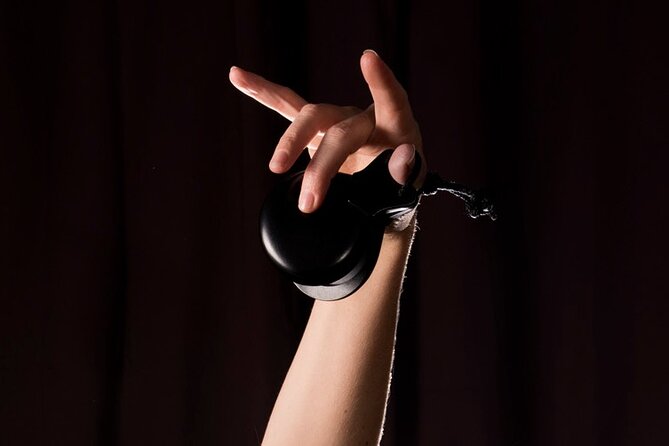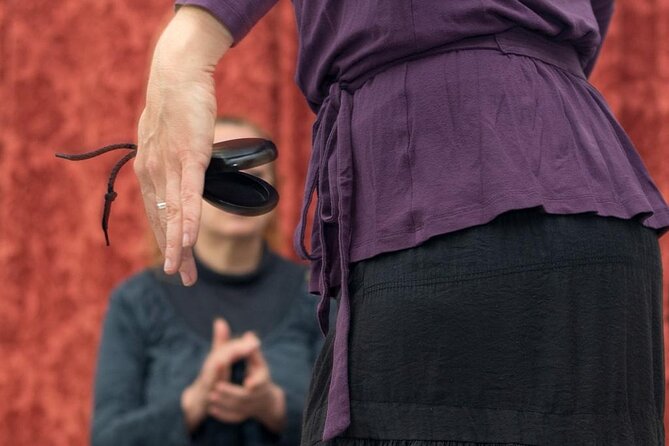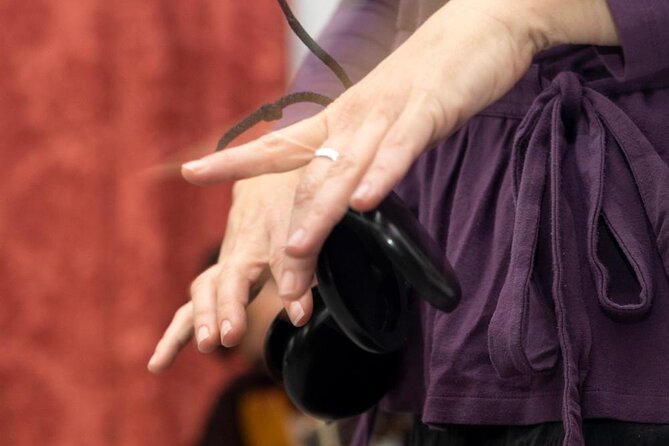Castanets have long been a captivating part of Spanish culture, and now you can learn to master these unique percussion instruments. In this introductory class, you’ll dive into the history and significance of castanets, picking up proper techniques for holding and playing them. As you practice rhythmic patterns and timing, you’ll build coordination and start to feel the pulse of Spanish music. By the end, you’ll have a newfound appreciation for this vibrant tradition – and perhaps even a new creative outlet to explore.
Key Points

- Understand the historical origins and cultural significance of castanets in Spanish music and dance.
- Learn proper castanet technique, including grip, wrist movements, and coordination for producing clear, rhythmic clicks.
- Explore fundamental rhythmic patterns and timing, starting with basic quarter and eighth notes, and progressing to complex syncopations.
- Develop the ability to synchronize castanet rhythms with various Spanish musical styles and enhance overall musical expression.
- Properly care for and maintain castanets to ensure their longevity and optimal performance.
Explore the History of Castanets

Originating from the Iberian Peninsula, castanets have a rich and captivating history that’s deeply woven into the cultural fabric of Spain.
These rhythmic percussion instruments have been used in traditional Spanish music and dance for centuries, with roots tracing back to the Moorish influence in the region.
Castanets gained widespread popularity during the golden age of Spanish dance in the 18th and 19th centuries, becoming synonymous with the lively and passionate performances of flamenco.
Today, they remain an integral part of Spanish cultural heritage, used not only in music and dance, but also in various religious and ceremonial celebrations across the country.
You can also read our reviews of more tours and experiences in Seville.
Proper Castanet Technique

Mastering the art of playing castanets begins with understanding the proper technique. First, hold the castanets comfortably in your hands, with your fingers curled around the edges. Your thumbs should rest on top of the castanets, providing stability and control.
When playing, the castanets should click together sharply, creating a crisp, rhythmic sound. Experiment with different grip pressures and wrist movements to find the right balance between control and fluidity. Remember to keep your wrists flexible and your arms relaxed.
With practice, you’ll develop the coordination and muscle memory to execute intricate castanet patterns. The key is to start slow, gradually building speed and confidence. Soon, you’ll be clacking away with the best of them.
Rhythmic Patterns and Timing

With a solid grasp of proper castanet technique, players can start exploring rhythmic patterns and timing. Castanets offer a wide range of rhythmic possibilities, from steady beats to complex syncopations. Beginners can start with simple patterns, like quarter notes and eighth notes, before progressing to more advanced rhythms.
| Rhythm | Description |
|---|---|
| Quarter Notes | Steady, even beats |
| Eighth Notes | Faster, more lively rhythm |
| Triplets | Three notes in the time of two |
Timing is crucial in castanet playing, as the dancer’s movements must be perfectly synchronized with the rhythms. Practicing to a metronome or music can help develop a strong sense of rhythm and timing, essential for creating captivating castanet performances.
Accompaniment to Spanish Music
Once players have a solid grasp of rhythmic patterns and timing, they can start exploring how to use castanets to accompany traditional Spanish music.
Castanets are an integral part of many Spanish musical styles, from flamenco to folk songs. By learning to play castanets in sync with the rhythm and melody of the music, beginners can add a lively, authentic touch to their performance.
This skill requires keen listening and the ability to anticipate the musical phrasing. With practice, castanet players can become skilled accompanists, weaving intricate rhythms that complement the primary instruments and vocals.
Mastering this aspect of castanet playing opens up a whole new world of musical expression and appreciation for Spanish culture.
Customizing Your Castanet Experience

Oftentimes, travelers seek to personalize their castanet experience beyond the basic introduction class.
The instructors at the Castanets for Beginners: Introduction Class are happy to accommodate such requests.
Some popular customization options include:
- Private lessons for individuals or small groups, allowing for a more tailored learning experience.
- Themed workshops that incorporate castanets into traditional Spanish dance styles, such as flamenco or sevillanas.
- Opportunities to perform with the castanets, either within the class or at local cultural events, providing a chance to showcase newly acquired skills.
These customizations elevate the learning experience and create a truly memorable castanet journey in Seville, Spain.
- Flamenco Show at Casa De La Memoria Admission Ticket
- Seville: Traditional Flamenco & Tapas Evening Tour
- Cathedral, Alcazar and Giralda Guided Tour With Priority Tickets
- Cordoba & Carmona With Mezquita, Synagoge & Patios From Seville
- Seville Tapas, Taverns & History Small Group Tour
- Skip the Line: Tablao Flamenco Pura Esencia Ticket
Caring for Your Castanets
Properly caring for your castanets is essential to ensuring their longevity and optimal performance.
Begin by wiping them clean after each use with a soft, dry cloth. Avoid exposing the castanets to excessive moisture, heat, or direct sunlight, as these can cause warping, cracking, or discoloration.
Store them in a cool, dry place when not in use. Regularly inspect the screws or fasteners and tighten them if necessary.
With proper care, your castanets will provide years of joyful music-making. Remember, well-maintained castanets will respond better, producing a crisper, more resonant sound.
Treat them with care, and they’ll serve you well on your castanet journey.
Recommended Accessories
To get the most out of your castanet-playing experience, consider investing in a few key accessories.
A carrying case or bag is essential for protecting your castanets when not in use and making them easy to transport. Look for one with padded compartments to keep your castanets secure.
Plus, a metronome can be incredibly helpful in developing your timing and rhythm.
Finally, a practice pad or mute can allow you to play quietly while perfecting your technique without disturbing others.
With the right accessories, you’ll be on your way to becoming a confident castanet player in no time.
- Carrying case or bag
- Metronome
- Practice pad or mute
Upcoming Class Schedule
The upcoming class schedule for Castanets for Beginners offers multiple opportunities for aspiring castanet players to hone their skills.
Classes are held regularly in Seville, Spain, with the next session scheduled for May 1st. Priced affordably at €20 per person, the class accommodates up to 6 travelers, ensuring personalized attention from the experienced instructor.
Classes take place in the historic Casco Antiguo district, conveniently located near public transportation. Participants can look forward to using high-quality castanets provided during the workshop.
With free cancellation up to 24 hours before the class, the Castanets for Beginners introduction is an accessible and flexible option for those eager to learn this traditional Spanish art form.
Frequently Asked Questions
What Should I Wear to the Class?
For a beginner’s class like this, comfort should be the priority. Wear loose, casual clothing that allows for easy movement. Closed-toe shoes are recommended to protect your feet. Bring a small towel or cloth to wipe your hands if needed.
Can I Bring My Own Castanets?
You can bring your own castanets, but the class will provide good quality ones for use during the workshop. This ensures everyone has the necessary equipment to fully participate and learn the basics.
Is There a Discount for Groups?
The class offers a group discount for larger parties. The price per person varies based on the total group size, with a maximum of 6 travelers allowed. Travelers should inquire about the group rate when booking the class.
Can I Get a Refund if I Need to Cancel?
Yes, you can get a full refund if you need to cancel your booking up to 24 hours before the experience starts. The company offers free cancellation, so you don’t have to worry about losing your money.
Is There a Beginner Level Class Available Later?
Yes, there is a beginner level Castanets class available later. The class details indicate it’s an introductory course suitable for travelers with any experience level, so beginners can easily sign up for a future session.
The Sum Up
Castanets offer a captivating way to take in Spanish cultural traditions. This introductory class provides a solid foundation, teaching beginners the essentials of castanet playing. With practice, students will develop the skills to accompany lively Spanish music and dances. Whether you’re a music enthusiast or simply curious, this class is the perfect starting point to discover the enchanting world of castanets.
More Workshops & Classes in Seville
More Tour Reviews in Seville
Not for you? Here's more nearby things to do in Seville we have reviewed
- Historic Seville Sunset Bike Tour
- Seville: Enjoy a class of approach to flamenco
- Seville: Cathedral and Giralda Guided Tour with Tapas
- SEVILLE: ROYAL ALCAZAR TOUR
- Seville: Guided Tour by Electric Bike
- Seville: 1.5-Hour Daytime Standup Paddleboarding Tour
- Seville: City Highlights & Hidden Gems Private Walking Tour
- Seville: Personal Holiday Photoshoot
- Seville: Secret Food Tour with Tapas and Drinks
- Guided Tour of the Royal Alcázar of Seville in a Small Group
- Seville: Flamenco Show at Tablao La Cantaora
- Seville: Tasting, History, Market visit and Tapas Tour
